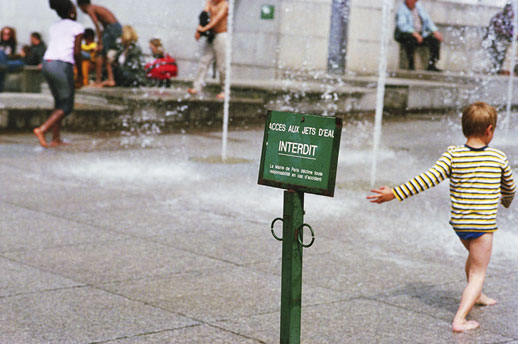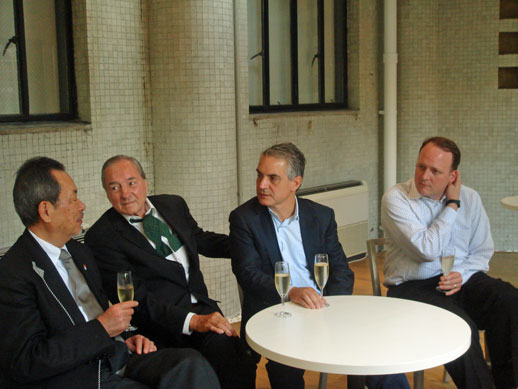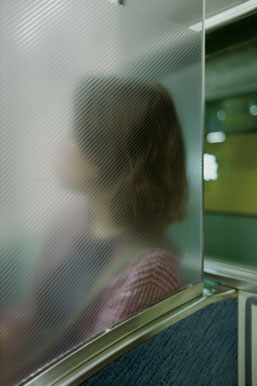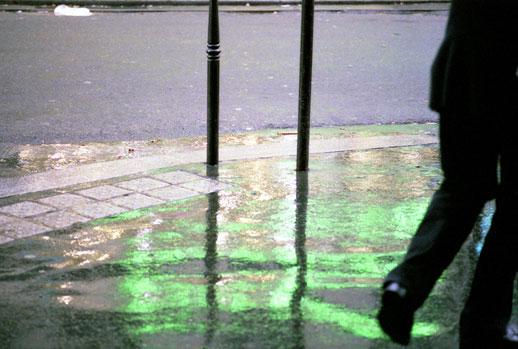Eggleston in Japan
What is now an accepted and almost expected format of photography was once a vista that many artists had reservations towards. Color photography was still a relatively new medium when John Szarkowski, Director of the Department of Photography at the Museum of Modern Art in New York City, curated William Eggleston’s first solo exhibition of color photography in 1976. In “William Eggleston’s Guide”, a monograph that was published in light of the solo exhibition, Szarkowski presents Eggleston as a color photographer working in the context of a fledging era for this medium.
Over four decades after his striking debut as a fine arts color photographer, the Cartier Fondation pour l’Art Contemporain in collaboration with the Hara Museum of Contemporary Art has finally brought the seminal photographer, William Eggleston, to Japan, where his work is highly regarded and admired. At the press conference the Hara Museum curator for this exhibition noted the unusually large crowd compared to previous occasions.
The exhibition mainly showcases two bodies of work that were each commissioned by the Cartier Fondation pour l’Art Contemporain. Galleries I and II and the hallways on the first floor of the museum showcase works from the “Paris” collection, while the second floor’s Gallery IV and V display the “Kyoto” collection, and Gallery III provides art historical context in the form of seven photographs from “William Eggleston’s Guide” taken in Memphis, on loan from the Tokyo Metropolitan Museum of Photography.

The “Paris” series, which don’t have much indication that they were taken in Paris other than the occasional French signs captured in the photographs (and even then, it could be a different city), are the first formal series of photographs in color taken of the city since the great photographers of the early days, who worked in black and white film. The Fondation’s aim to revitalize Paris as a photographical subject is quite successful. The photographs are welcoming even to the unassuming visitor not aware of William Eggleston’s eminence. The private residence-turned-museum first draws the audience into the spacious yet intimate Gallery I. The framed photographs 28 x 35.6cm in size are horizontally lined up on the white walls, without curatorial plaques, merely conveying the brightness of the colors and composition of forms that Eggleston has captured. A photograph of a woman’s feet in red high-heeled Mary Janes, suspended in mid-air, hangs alone above the mantelpiece as if to accentuate the ambiguity of what happens after that moment.

In the curved hallway leading to Gallery II a series of what Eggleston himself calls “abstracts” line the wall. Each piece in a vertical, rectangular format is filled to the brim with vibrant lines and squiggles of markers and fluorescent pen and different textures of papers from sketchbooks to notepads. Publicly exhibited for the first time, these paintings represent the starting point from which Eggleston explored art as a young child, even before he discovered photography as his professional medium. The spontaneous yet harmonic nature of the abstracts is almost like a conveyance of his mind as a visual as well as a musical artist, according to Fondation curator Grazia Quaroni.
 Once stepping into the lowly lit Gallery II, spotlights are on the framed photographs; one immediately feels a sense of awareness of discovering the esprit that is William Eggleston. The “Paris” series continues to exhibit Eggleston’s keen eye for a chromatic range of visual experiences, with subjects ranging from carnival rides or an empty ampitheater, to a little boy stepping into a public fountain. Framed pairs of photographs and abstracts are also exhibited, taken from the “Paris” catalogue published by the Fondation, which Eggleston edited and arranged himself. The issue of self-curation by artists, which has been a point of contention, is cleverly manifested and braided into this exhibition.
Once stepping into the lowly lit Gallery II, spotlights are on the framed photographs; one immediately feels a sense of awareness of discovering the esprit that is William Eggleston. The “Paris” series continues to exhibit Eggleston’s keen eye for a chromatic range of visual experiences, with subjects ranging from carnival rides or an empty ampitheater, to a little boy stepping into a public fountain. Framed pairs of photographs and abstracts are also exhibited, taken from the “Paris” catalogue published by the Fondation, which Eggleston edited and arranged himself. The issue of self-curation by artists, which has been a point of contention, is cleverly manifested and braided into this exhibition.
The “Kyoto” series on the second floor continues to show Eggleston’s unique style of capturing cities and their personalities. Kyoto, which happens to be his favorite city, was a natural choice for the “go-as-you please” project commissioned by the Foundation. Once again, the only way we can start to identify the location of the series is by Japanese signs in the images. The iconic temples, Zen gardens and geisha that Japanese tourist bureaus have identified and reappropriated, are non-existent in these daily scenes from an urban landscape. Fresh fish swimming in a tank, a woman’s profile obscured by translucent glass, colorful gerberas, tiled floors and dead fish lying on beds of ice… Interestingly enough, I noted a particular occurrence of reflections in several of the photographs, which was further enhanced by the framing glass, the lighting in the galleries, and the large size of the prints (76 x 61 ~ 101.5cm). According to Eggleston, the size was an arbitrary choice made by his New York City gallery, while the reflections gradually appeared as a theme over the course of his journey. This spontaneous phenomenon, created as a result of the art and curation, results in a peculiar discovery and interaction with Eggleston’s photography as you see your shadow lurking in the frames.
After the press conference, William Eggleston sat in the café smoking a cigarette while enjoying a glass of champagne as he looked outside where dusk was setting upon the museum garden. The comfort and elegance with which he poised himself was a direct reflection of the photographs, which according to him, couldn’t have been placed in a more perfect location than the Hara Museum of Contemporary Art.

Sol Jung
Sol Jung



